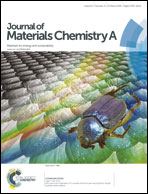Application of sulfur-doped carbon coating on the surface of Li3V2(PO4)3 composites to facilitate Li-ion storage as cathode materials†
Abstract
In an optimized modification approach, sulfur-doped carbon coating is initially applied to improve the electrochemical properties of Li3V2(PO4)3 cathode material. The existence and formation of sulfur doping in the carbon-coating layer was confirmed by XPS and EDX mapping, and furthermore it was found that various carbon–sulfur species had a significant impact on improving the electronic conductivity and defect level of the surface carbon layer of Li3V2(PO4)3 composites. Therefore, we unexpectedly demonstrated that, when compared with bare Li3V2(PO4)3/C, sulfur-doped carbon-coated Li3V2(PO4)3 exhibits a more outstanding electrochemical performance, especially with regard to the cycle capability and rate stability. For instance, when the discharge rate was increased from 0.5 C to 50 C, the capacity of Li3V2(PO4)3/C + S only decayed from 122.1 mA h g−1 to 106.4 mA h g−1, indicating an amazing capacity retention of 87%. This novel modification method of S-doped carbon coating is highly effective and could be widely used to optimize the electric conductivity of electrode materials for Li-ion batteries.


 Please wait while we load your content...
Please wait while we load your content...